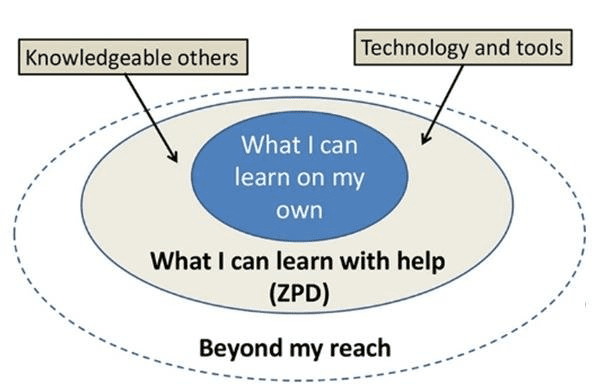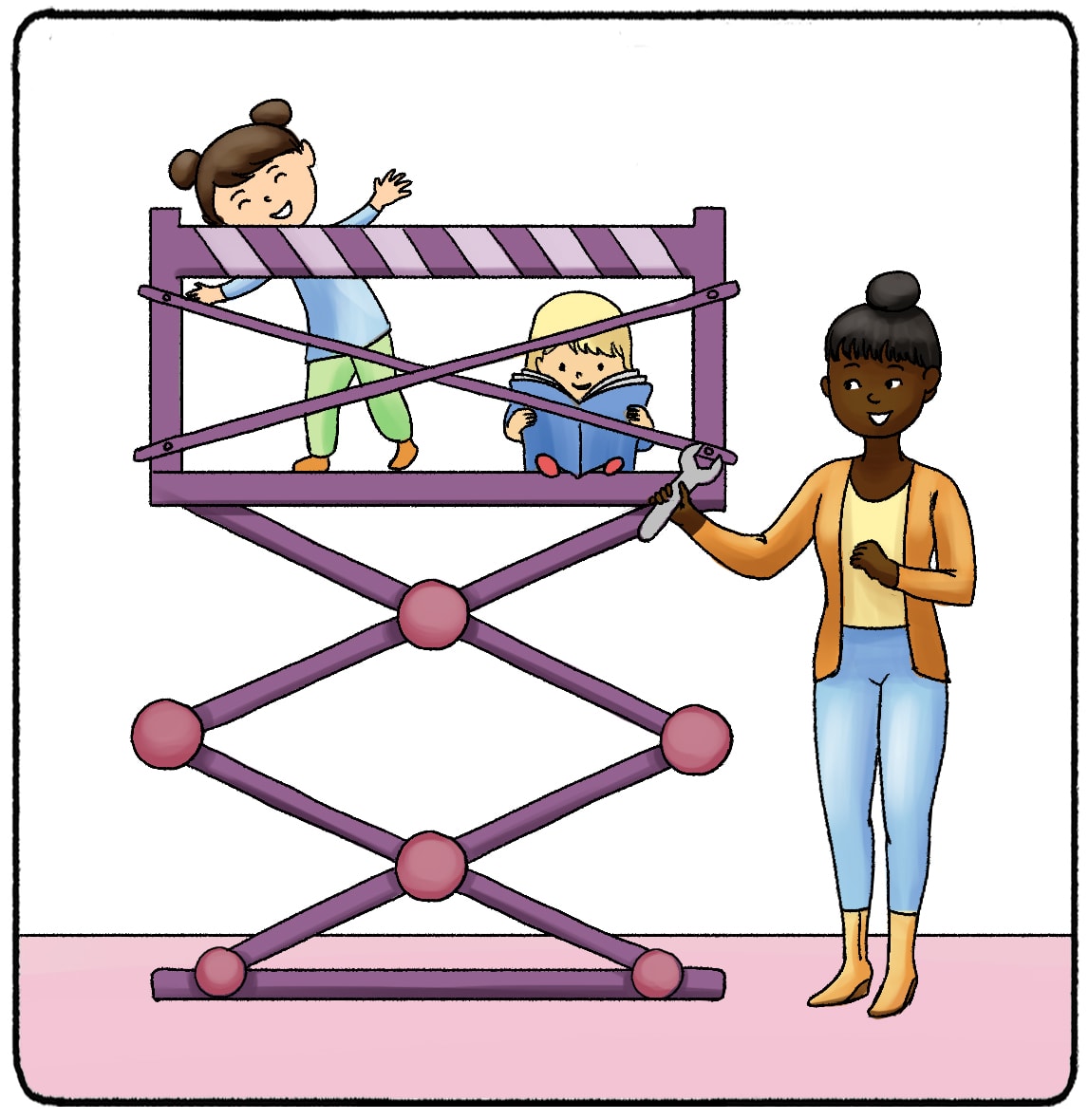Think about all of the skills that you want to learn. Maybe you want to learn how to build your own house. At the moment, you have minimal experience building. You can read a blueprint and use basic hand tools but wouldn’t even know where to begin building a house.
So how do you get from A to Z? First, you figure out how to get from A to B or A to C. Psychologists often apply the Zone of Proximal Development theory to this approach to guide educators and leaders as they teach new skills.

What is the Zone of Proximal Development?
The Zone of Proximal Development (ZPD) is a central concept developed by Russian psychologist Lev Vygotsky, aiming to delineate the boundaries of an individual's learning potential. It specifically pinpoints the difference between what a learner can achieve without assistance, termed their 'actual developmental level,' and what they can achieve when supported by a more knowledgeable individual, like a teacher, mentor, or peer.
The foundational idea behind ZPD is that true, impactful learning often happens in this 'zone.' While tasks that are too easy might not offer much cognitive growth, tasks that are far too challenging can lead to frustration and a sense of defeat. However, tasks within the ZPD can be approached with guided assistance, allowing learners to stretch their capacities and gradually internalize new skills.
Guided learning, often termed "scaffolding," is pivotal in the ZPD framework. This process involves the mentor providing tailored support based on the learner's abilities. As the learner becomes more competent, this guidance can be reduced incrementally, allowing the learner to become more independent. This dynamic interaction emphasizes that learning is not a solitary endeavor but is deeply collaborative, with the mentor and learner working in tandem to navigate challenges and achieve mastery.
Vygotsky's concept of ZPD underscores the importance of context and social interaction in learning. By understanding and harnessing the power of the ZPD, educators, and mentors can create optimal learning environments that promote growth, skill acquisition, and confidence in learners.
How Does the Zone of Proximal Development Work?
Knowledge and skills exist on a spectrum. On one end, there are skills you've mastered, like simple arithmetic. On the other end, there are tasks currently beyond you, like complex calculus.
Between these extremes lies a transitional zone, the Zone of Proximal Development (ZPD). In this zone, tasks are challenging but attainable with the right guidance. This guidance often comes from a “More Knowledgeable Other” (MKO). An MKO isn't universally more knowledgeable across all subjects or topics. Instead, they have specific expertise or a deeper understanding in the area being learned. They provide direction, feedback, and support as learners venture into new territories of understanding.
Real-life applications of ZPD in educational settings include:
- Group Projects: Students with varied abilities are often grouped together in a classroom. A student who excels in research but struggles with presentation might be paired with another who's the opposite. Together, they guide each other, acting as MKOs in their areas of strength.
- Tutoring: A tutor with a clearer grasp of a subject can guide students through challenging areas. The tutor doesn't just provide answers but facilitates the student's journey to find the solutions, keeping them within their ZPD.
- Workshops: In workshops, hands-on tasks can be used to teach students new skills. With the assistance of an instructor or more experienced peers, students can practice and learn techniques that might be too difficult to tackle independently.
- Flipped Classrooms: Students first engage with new content at home, usually through videos or readings, and then come to class to apply their new knowledge with the guidance of their teacher and peers. This approach ensures students are always working within their ZPD, as they can seek help when they encounter challenging tasks.
By recognizing and utilizing the ZPD, educators can ensure that students consistently work in an area where they're challenged but not overwhelmed. It's a delicate balance, but one that, when struck correctly, can lead to optimal learning outcomes. The principles of the ZPD remind educators that with the right support and guidance, students can achieve much more than what might seem possible when left to their own devices.
Example of the Zone of Proximal Development
Framing a house may be one of these skills. You need the ability to use hand tools and read a blueprint, but it’s just one component of building a house. A master carpenter can lead you through framing a few times before you can do this skill on your own or delegate this task to a team.
MKOs aren’t meant to hold the student’s hand or necessarily do the skill for the student. Effective MKOs simply offer guidance, tips, and suggestions. The proper guidance may also depend on the student’s acquired skills and how they learn best.
How Does Zone of Proximal Development Work in Learning and Education?
Does an MKO necessarily need to be an expert, teacher, or even an adult? Not necessarily. Vygotsky defined an MKO as someone who better understood a skill, task, or concept than the person learning. Sometimes, that someone is a teacher or a parent. Other times, a student in the classroom helps another student. Teachers may effectively plan group activities or assign classmates using this theory.

Vygotsky strongly advocated for social interaction, which he viewed as a cooperative dialogue. Through this cooperative dialogue, the student can perform and internalize the task. This is when the real learning happens. Once the task is internalized, the students can guide themselves through it and complete it without guidance from an MKO.
Scaffolding
Vygotsky developed the Zone of Proximal Development in the latter years of his short life. He passed away at the age of 37 from tuberculosis. His innovative work laid the groundwork for several educational theories and practices. However, it's essential to differentiate between his original concepts and subsequent ideas that emerged, inspired by his work.

When discussing Vygotsky's Zone of Proximal Development, many educators often bring up the concept of "Scaffolding." It's important to note that while scaffolding aligns with Vygotsky's ideas about learning, the term "scaffolding" was not coined by Vygotsky. Instead, later psychologists introduced it, drawing inspiration from Vygotsky's foundational work.
Scaffolding can be understood as a structured approach where skills are acquired sequentially. It suggests that certain foundational skills must be mastered before progressing to more complex ones. As learners ascend this metaphorical scaffold, they become more independent, necessitating less instructional intervention.
To illustrate scaffolding in practice:
- Modeling: The educator demonstrates a skill that the student subsequently attempts and internalizes.
- Material Adaptation: Lessons or materials are tailored to align with a student’s skill level.
- Verbal Guidance: Providing verbal cues, prompts, or clues to guide the student.
- Engagement: Ensuring the student's attention is sustained throughout the learning process.
Accurately assessing a student's Zone of Proximal Development becomes paramount in scaffolding. An effective assessment ensures the instruction aligns with the student's ZPD. This is consistent with Vygotsky's belief that learning is a step-by-step process. Missing a step or rushing ahead could hinder a student's grasp of subsequent skills.
How to Apply The Zone of Proximal Development To Your Goals
- Self-Assessment: Begin by introspectively understanding where you currently stand in your learning journey. Identify areas you're proficient in and areas that pose challenges. This will help you pinpoint your own ZPD, which is the area where guidance will be most effective.
- Identify Your Learning Style: Reflect on past learning experiences. What methods have been most effective for you? Do you grasp concepts better through hands-on experience, visual demonstrations, or verbal explanations? Recognizing your preferred learning style will enhance the efficacy of the guidance you receive.
- Find Your MKO: Look for someone or something that can guide you in that challenging area. It could be a mentor, online courses, tutorials, or even a knowledgeable peer. This "More Knowledgeable Other" will act as your guide within your ZPD.
- Engage Actively with Your MKO: Seek their assistance once you've identified it. Communicate your needs, discuss your preferred learning style, and be open to feedback. Remember, collaboration and interaction are key elements in Vygotsky's theory.
- Practice & Reflect: Practice the skill independently after learning with your MKO. Reflect on your progress. Have you grasped the concept? Can you perform the skill independently? If not, consider revisiting the guidance or seeking alternative methods of learning.
- Progress & Repeat: As you master skills within your current ZPD, your ZPD will shift, encompassing more advanced skills. Re-evaluate and repeat the process. Continually reassessing and adjusting ensures continuous growth.
Understanding and applying Vygotsky's Zone of Proximal Development in our personal learning endeavors can streamline our efforts and maximize our learning experiences. Recognizing where we need guidance and from whom can unlock vast potentials and enable us to grow and adapt in an ever-changing world continually.
